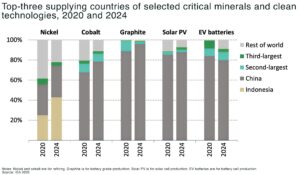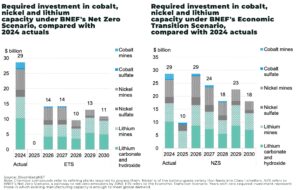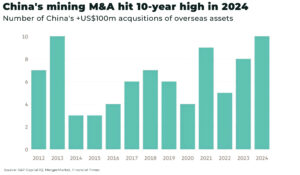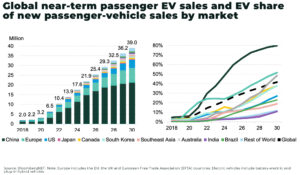Critical Minerals and Energy Intelligence
Lithium
Demand for lithium is forecast to increase up to x40 times between 2022 – 2040, driven by global sales of electric cars and batteries.
The top three lithium producing countries are currently Australia, Chile and China, accounting for over 90% of global production.
Investment in exploration outside of the “lithium triangle” — Chile, Bolivia, Argentina — which holds roughly 85% of the world’s lithium reserves, is finding significant new hard rock opportunities for investors.
Lithium Insights
Industry lithium report
The supply of lithium, essential for electric vehicles, is expected to face twenty years of rapid growth, according to our new report. The Oregon Group forecasts lithium’s dominant demand segment — electric batteries and vehicles (EVs) — is also it’s fastest growing, a dynamic rarely encountered even in bull markets.
Report: Inside the accelerating global race for lithium
Latest infographics on lithium:
Lithium (Li)
Lithium, atomic number 3, is a soft, silvery-white alkali metal renowned for its exceptional energy density, low weight, and reactivity. With a melting point of 180.5°C, lithium is the lightest solid element and plays a foundational role in the global shift toward electrification and decarbonization.
As demand for electric vehicles (EVs), renewable energy storage, and portable electronics accelerates, lithium’s status as a critical mineral is firmly established—powering the batteries that drive the clean energy transition.
Why lithium matters: strategic applications
Electrification and energy storage
Lithium is indispensable in the transition to sustainable energy due to its unique electrochemical properties:
electric vehicles (EVs): Lithium-ion batteries are the standard for EVs, offering high energy density and long cycle life. Global EV adoption is projected to drive lithium demand up 84–174% from 2025 to 2030, and as much as 289% by 2035 in growth scenarios
renewable energy storage: Lithium-based batteries are critical for grid-scale storage, enabling reliable integration of intermittent solar and wind power and ensuring energy availability around the clock
consumer electronics: Smartphones, laptops, and tablets rely on lithium-ion batteries for lightweight, long-lasting power
Industrial and specialty uses
aerospace alloys: Lithium is alloyed with aluminum, copper, and manganese to produce strong, lightweight materials for aircraft and advanced manufacturing
glass and ceramics: Lithium compounds improve thermal shock resistance in specialty glass and ceramics
lubricants and greases: Lithium hydroxide is a key thickening agent in high-performance lubricants and greases for industrial machinery
Supply and demand dynamics
Demand drivers
EV and battery growth: The rapid expansion of EVs and stationary energy storage is the dominant force behind surging lithium demand
technology innovation: Larger battery packs and next-generation battery chemistries are increasing lithium intensity per unit, amplifying demand
global policy: Ambitious climate targets and government incentives for clean transportation and energy storage are accelerating lithium adoption worldwide
Supply challenges
production bottlenecks: After years of oversupply, the lithium market is tightening in 2025 due to production cuts, shifting demand, and geopolitical tensions
resource concentration: The lithium supply chain is highly concentrated, with Australia, Chile, and China dominating global production and refining
environmental and social concerns: Water-intensive extraction, especially from South American brines, and community opposition in key mining regions pose ongoing risks to supply growth
Major producers
Albemarle Corporation (USA): the world’s largest lithium producer, with operations in North America, Chile, and Australia
SQM (Chile): a leader in South American brine extraction and lithium processing
Ganfeng Lithium (China): a vertically integrated producer with global mining and refining assets
Tianqi Lithium (China/Australia): a major player with interests in the world’s largest hard-rock lithium mine
Market trends shaping lithium’s future
clean energy transition: lithium demand will continue to surge as countries invest in EVs, grid storage, and renewable energy infrastructure, cementing its role as the backbone of the battery supply chain
recycling growth: Lithium-ion battery recycling is expanding rapidly, with North America and Europe scaling up capacity to recover critical materials and reduce reliance on primary supply
geopolitical dynamics: Trade policies, resource nationalism, and environmental regulations are reshaping the global lithium market, with countries seeking to secure domestic supply chains and maximize economic benefits
Lithium’s unmatched energy storage capabilities make it essential for electrification, renewable energy systems, and advanced manufacturing. As the world pivots toward sustainability and technological innovation, robust lithium demand will persist—solidifying its position as a cornerstone of the modern energy economy.

The next energy shock won’t be oil — it’ll be critical minerals, warns IEA
Key takeaways The International Energy Agency’s World Energy Outlook 2025 redefines energy security for the electric age: not oil or gas, but critical minerals are

US Government takes 5% stake in Lithium Americas’ Nevada project
The US government will take a 5% equity stake in Lithium Americas’ joint venture with General Motors, tightening its grip on strategic minerals and marking

Why the US fails to secure critical mineral supply — and how it can be fixed
An inside look into what’s gone wrong in Washington — and how to fix it In December 2024, China banned exports of gallium, germanium, and antimony

Is this the “shale moment” for critical mineral mining in the US?
A quiet revolution is underway in the bedrock of the global economy. The mining and processing of critical minerals — from lithium to rare earths,

Battery metals demand set to quadruple by 2040
Global demand for battery metals is forecast to x4 over the next 15 years, even as near-term growth moderates, according to BloombergNEF’s latest Electric Vehicle

US announces US$1 billion to secure critical mineral supply
The US Department of Energy has announced plans to deploy nearly US$1 billion in new funding opportunities to build out America’s domestic critical minerals supply












